Related Research Articles

Hawaii is an island state of the United States, in the Pacific Ocean about 2,000 miles (3,200 km) southwest of the U.S. mainland. It is the only state not on the North American mainland, the only state that is an archipelago, and the only state in the tropics.

Honolulu is the capital and most populous city of the U.S. state of Hawaii, which is in the Pacific Ocean. An unincorporated city, it is the county seat of the consolidated City and County of Honolulu, situated along the southeast coast of the island of Oʻahu, and is the westernmost and southernmost major U.S. city. Honolulu is Hawaii's main gateway to the world. It is also a major hub for business, finance, hospitality, and military defense in both the state and Oceania. The city is characterized by a mix of various Asian, Western, and Pacific cultures, reflected in its diverse demography, cuisine, and traditions.
The music of Hawaii includes an array of traditional and popular styles, ranging from native Hawaiian folk music to modern rock and hip hop. Styles like slack-key guitar are well known worldwide, while Hawaiian-tinged music is a frequent part of Hollywood soundtracks. Hawaii also made a contribution to country music with the introduction of the steel guitar. In addition, the music which began to be played by Puerto Ricans in Hawaii in the early 1900s is called cachi cachi music, on the islands of Hawaii.
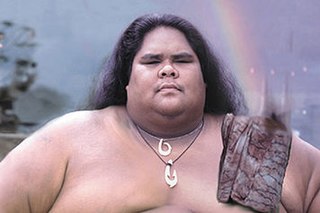
Israel Kaʻanoʻi Kamakawiwoʻole, also called Braddah IZ or just simply IZ, was a Native Hawaiian musician and singer. He achieved commercial success and popularity outside of Hawaii with his 1993 studio album, Facing Future. His medley of "Somewhere Over the Rainbow/What a Wonderful World" was released on his albums Ka ʻAnoʻi and Facing Future, and was subsequently featured in various media. The song has had 358 weeks on top of the World Digital Songs chart, making it the longest-leading number-one hit on any of the Billboard song charts. Kamakawiwoʻole is regarded as one of the greatest musicians from Hawaii and is the most successful musician from the state.

Jack Hody Johnson is an American singer-songwriter, primarily in the soft rock and acoustic pop genres. Johnson has reached number one on the Billboard 200 chart with his albums Sing-A-Longs and Lullabies for the Film Curious George in 2006, Sleep Through the Static in 2008, To the Sea in 2010 and From Here to Now to You in 2013. His album In Between Dreams peaked at number two on the chart in 2005 and again in 2013.
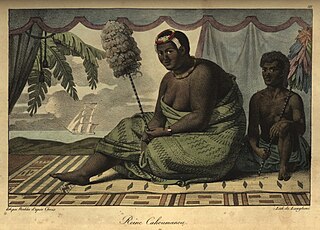
Kaʻahumanu was queen consort and acted as regent of the Kingdom of Hawaiʻi as Kuhina Nui. She was the favorite wife of King Kamehameha I and also the most politically powerful, and continued to wield considerable power as co-ruler in the kingdom during reigns of his first two successors.

Kamehameha IV, reigned as the fourth monarch of Hawaii under the title Ke Aliʻi o ko Hawaiʻi Pae ʻAina of the Kingdom of Hawaii from January 11, 1855, to November 30, 1863.

Robert William Kalanihiapo Wilcox, nicknamed the Iron Duke of Hawaiʻi, was a Native Hawaiian whose father was an American and whose mother was Hawaiian. A revolutionary soldier and politician, he led uprisings against both the government of the Hawaiian Kingdom under King Kalākaua and the Republic of Hawaii under Sanford Dole, what are now known as the Wilcox rebellions. He was later elected the first delegate to the United States Congress for the Territory of Hawaii.

Herbert Kawainui Kāne, considered one of the principal figures in the renaissance of Hawaiian culture in the 1970s, was a celebrated artist-historian and author with a special interest in the seafaring traditions of the ancestral peoples of Hawaiʻi. Kāne played a key role in demonstrating that Hawaiian culture arose not from some accidental seeding of Polynesia, but that Hawaiʻi was reachable by voyaging canoes from Tahiti able to make the journey and return. This offered a far more complex notion of the cultures of the Pacific Islands than had previously been accepted. Furthermore, he created vivid imagery of Hawaiian culture prior to contact with Europeans, and especially the period of early European influence, that sparked appreciation of a nearly forgotten traditional life. He painted dramatic views of war, exemplified by The Battle at Nuʻuanu Pali, the potential of conflicts between cultures such as in Cook Entering Kealakekua Bay, where British ships are dwarfed and surrounded by Hawaiian canoes, as well as bucolic quotidian scenes and lush images of a robust ceremonial and spiritual life, that helped arouse a latent pride among Hawaiians during a time of general cultural awakening.

Honolulu is a city magazine covering Honolulu and the Hawaii region. It dates back to 1888 when it was called Paradise of the Pacific. It is the oldest magazine in the state of Hawaii and is the longest published magazine west of the Mississippi. Honolulu is a member of the City and Regional Magazine Association (CRMA).

Edward Ryon Makuahanai Aikau was a Hawaiian lifeguard and surfer. As the first lifeguard at Waimea Bay on the island of Oahu, he saved over 500 people and became famous for surfing the big Hawaiian surf, winning several awards including the 1977 Duke Kahanamoku Invitational Surfing Championship. The Eddie Aikau Big Wave Invitational is named in his honor. He was also a crew member on the Polynesian voyaging canoe Hōkūleʻa.

Malik Joyeux was an accomplished all-around waterman and a professional Big Wave surfer. Known by many as the "petit prince", the goofy-foot surfer often gained attention for charging the treacherous barrels at Teahupoo, Tahiti. He was credited in 2003 with the Billabong XXL Tube of the Year for riding one of the largest waves ever to be surfed in history.
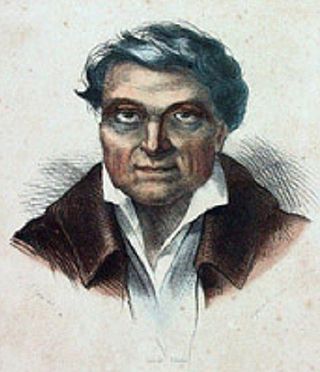
John Young was a British subject who became an important military advisor to Kamehameha I during the formation of the Kingdom of Hawaii. He was left behind by Simon Metcalfe, captain of the American ship Eleanora, and along with a Welshman Isaac Davis, and became a friend and advisor to Kamehameha. Young brought knowledge of naval and land battle strategies to Kamehameha, and became a strong voice on affairs of state for the Hawaiian Kingdom. He played a big role during Hawaii's first contacts with the European powers. He spent the rest of his life in Hawaiʻi. Between 1802 and 1812, John Young ruled as Royal Governor of Hawaii Island while King Kamehameha was away on other islands. He organized the construction of the fort at Honolulu Harbor. The Hawaiians gave him the name ʻOlohana based on Young's typical command "All hands ".

KDNN is a hawaiian contemporary hit radio formatted radio station based in Honolulu, Hawaii. The iHeartMedia, Inc. outlet broadcasts with an ERP of 51 kW. It also transmits on Oceanic Spectrum digital channel 851 for the entire state of Hawaii. Its studios are located in the Kalihi neighborhood of Honolulu, while its transmitter is located downtown.

Kui Lee was an American singer-songwriter. Lee began his career in the mainland United States while performing as a dancer. Upon his return to Hawaii, he worked in clubs. At the Honey club, he met Don Ho, who popularized Lee's compositions. Ho's fame made Lee a local success in Hawaii. Multiple artists then covered his song "I'll Remember You".
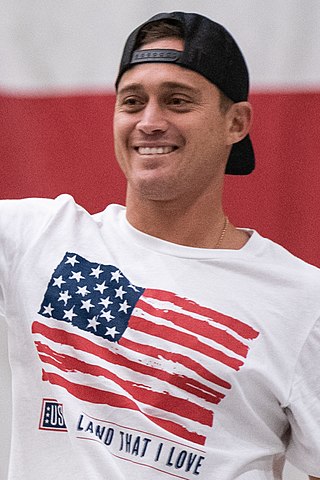
Makuakai (Makua) Rothman is an American big wave rider, professional surfer and musician. On February 28, 2015, he was crowned the 2015 Big Wave World Champion in the World Surf League's (WSL) first sanctioned Big Wave World Tour (BWWT).

Joshua Booth Green is an American politician and physician who has been the governor of Hawaii since 2022. A member of the Democratic Party, he is the state's ninth governor. He was the 15th lieutenant governor of Hawaii from 2018 to 2022, a member of the Hawaii Senate from 2008 to 2018, and as a member of the Hawaii House of Representatives from 2004 to 2008.
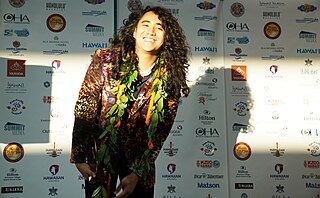
Kūkahi Lee, professionally known mononymously as Kūkahi, is a Native Hawaiian singer-songwriter, multi-instrumentalist, and record producer. Born and raised in Honolulu, Hawaii, Kūkahi began writing music at a young age and performed in musical venues around the world throughout his early teens. After graduating from high school in 2015, he founded an independent record label that is distributed and funded by Makaliʻi Productions.

Kalani Peʻa is a three-time Grammy Award winning singer-songwriter of Hawaiian music. He released his first album, E Walea, in 2016, which won the 2017 Grammy award for Best Regional Roots Music Album. Peʻa released his second album, No 'Ane'i, in 2018, which won the Grammy Award for Best Regional Roots Music Album at the 61st Annual Grammy Awards.

Danny "Kaniela" Kaleikini was an American singer, musical artist, and entertainer. Best known for his long-term residency at the Kahala Hilton in Hawaii, where he performed for 28 years, Kaleikini is often called "The Ambassador of Aloha". During his career of more than 50 years in show business, he was the opening act for Paul Anka at Caesars Palace in Las Vegas, and performed alongside Sammy Davis Jr., Wayne Newton, Dolly Parton, Phyllis McGuire, and Don Ho. A baritone who sang Hawaiian songs and played the nose flute, Kaleikini gained international recognition for promoting Hawaiian music, language, and culture.
References
- ↑ "Weldon Kekauoha biography". Last.fm. Retrieved October 7, 2022.
- 1 2 "Weldon Kekauoha". Big Island Now. June 3, 2017. Retrieved October 7, 2022.
- 1 2 Roby, Steve (July 26, 2021). "Weldon Kekauoha's Dreamy Concert Under the Stars". Big Island Music Magazine. Retrieved October 8, 2022.
- ↑ "Program Guide" (PDF). PBS Hawai‘i. 2018. Retrieved October 8, 2022.